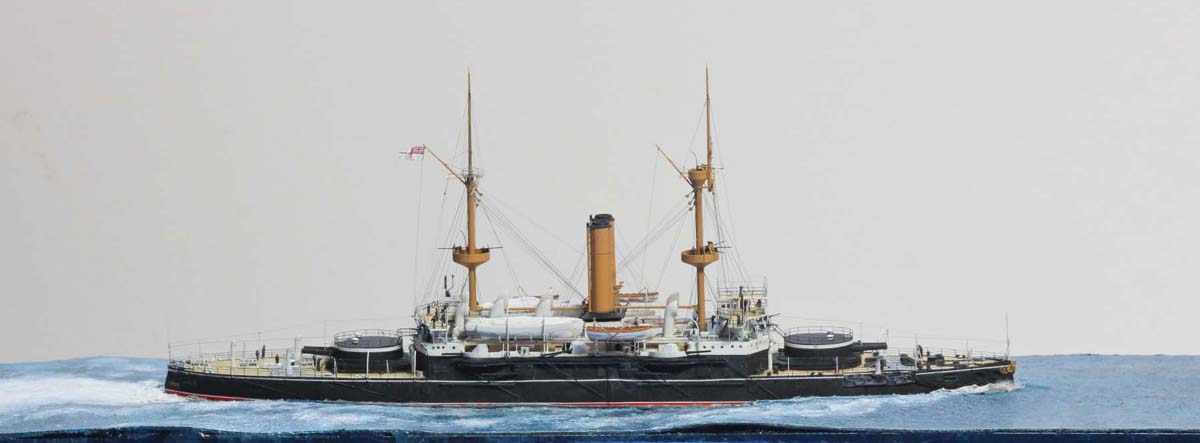
1/700 HMS Hood 1891 (Combrig)
|
by Jim Baumann |

Rather less famous than her ill-fated successor of 1918-1941, she nevertheless has an important place in History. The Pre-dreadnought HMS Hood was the last member of the eight ship Royal Sovereign class of RN Battleships. She differed dramatically from her near-sisters by having rotating turret gun houses, as opposed to the open barbettes of all the other the Royal Sovereign class ships. She was similar in all aspects, apart from missing a whole decks worth of freeboard fore- and-aft.! Compared to the other members of the class, she was allegedly a more stable gun platform due to lower metacentric height but at the expense being a rather poor seaboat in Channel and and Atlantic seaways; as well as being half a knot slower in calm water and significantly slower in rough seas by volume of water on the decks. This was noted by the Admiralty in very short order and in 1893 she was duly dispatched to the overall calmer waters of the Mediterranean Sea, operating out of Grand Harbour at Valetta in Malta.She returned to Britain in 1900, was placed into reserve, and almost immediately recommissioned as the guard-ship for Pembroke Dock. She returned to the Mediterranean fleet in 1901. from 1909 to 1911 she served as receiving ship and flagship at Queenstown Ireland Rendered obsolete by the new Dreadnought types she was listed for disposal On 4 November 1914 HMS Hood was scuttled as a blockship in Portland harbour (South-coast of England) so as to block the Southern Ship Channel, a potential access route for enemy U-boats or externally fired torpedoes. She was intended to sink upright and to be re-floated some day, alas obstinate as the ship was to the end - she turned turtle during the scuttling... and she lies there to this day - and was until recently popular for divers ! Her wreck became known as "Old Hole in the Wall".
The kit from Combrig at first sight promises much, alas there are some minor, though not insurmountable, accuracy issues and omissions , much of which took considerable time to correct and replace. A compromise that is common to I believe many the Combrig RN ships of this type is found here also; that being that the superstructure deck at either end of the boat-well deck is solid in the kit casting--when on the real ships these were undercut and mostly hollow To grind out this area and make all new decks for the well deck ass well as the superstructure at each end is a considerable amount of work, and once the ships boats are in place not that much can be seen of this area... but enough to make it, to my mind - worthwhile to embark upon this task. Having already ground out these large blocks of resin, then re-decked and re-made everything above it on my build of 1/700 HMS Magnificent - which can be read about here. I was therefore practiced and thereby ready to do it all again! For this and all the other minutia of material removal and rebuild... there is a reasonably comprehensive step-by-step thread of the build of 1891 HMS Hood right here in the MW.com forum Much of the superstructure is scratchbuilt, as are all small arms, torpedo net-shelves and the entire ships-boat supporting structure across the aforementioned well deck. along with pilothouses, flying decks and the entire rig, with the model being rigged-including the yard-arm footropes -entirely in stretched sprue. The most amusing aspects of the construction were making the huge bow scroll of brass wire and PE scraps, and cutting the individual tiny letters from an elderly GMM PE IJN fret and cobbling the letters into the name plate letters aft
This model frustrated and delighted at the same time, being a quirky and odd vessel in layout and appearance. Whilst well photographed, albeit not much on deck or overhead views and well documented in various well known books, especially in the NEW revised edition of the classic RA Burts British Battleships 1889-1904 which features a superb double-spread image in high resolution, alas neither the Burt drawing or the Burts drawing s were entirely accurate in quite some respects which perhaps mitigates some of Combrigs errors in the kit! The internet produced only the same previous published images in various quality resolution. Available images and plans of the near sister-ships of the Royal Sovereign class were not that helpful--as aside from Hood having wider athwarsthips spaced funnels, most of her deck layout was quite different in detail, along with virtually no similarities in vent shape, size and hatch positions! My breakthrough came when I obtained the new Norman Friedman Book 'British Battleships of the Victorian Era' within which published were the 'as-fitted' Admiralty drawings of Hood, which clarified much! Having survived transport, exhibition and the return journey to Telford , the model is now permanently at home safely in her glass case.
